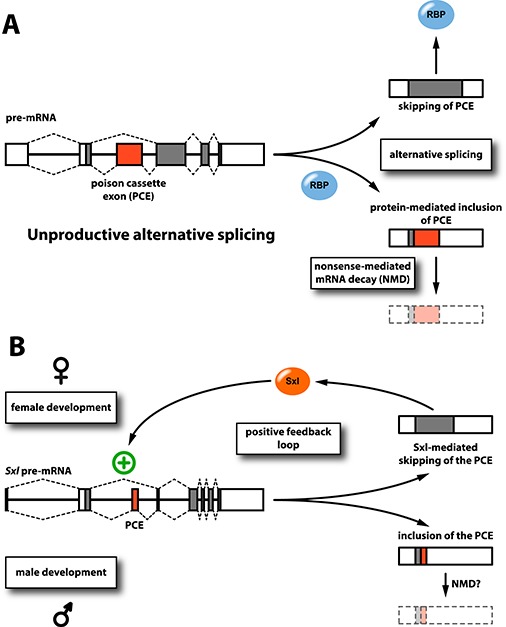Figure 2.

Common principles in feedback regulation to splicing. (A) Auto-regulation by unproductive AS creates a negative feedback loop. Auto-regulatory feedback is exerted by control of the inclusion of a PCE (highlighted in red) that contains a PTC. By default, splicing of the pre-mRNA (schematically depicted on the left) results in skipping of the PCE, generating an mRNA that encodes functional protein (depicted at the top). Once a critical concentration of the RBP is produced, it limits its own synthesis by promoting inclusion of the PCE during splicing (depicted below). This results in the generation of mRNAs with a shortened open reading frame that encodes a truncated and non-functional protein isoform. The presence of the PTC can furthermore trigger rapid mRNA destabilization and turnover via the NMD pathway. (B) Sxl auto-regulatory, positive feedback to AS generates a molecular switch that controls sexual development. Drosophila Sxl acts as a molecular switch that controls female development. Once produced, Sxl protein engages in an auto-regulatory positive feedback loop promoting skipping of a PCE in its own transcript (depicted at the top). This ensures lasting Sxl protein production and governs female development. Male development is characterized by the absence of functional Sxl protein and inclusion of the PCE during splicing. This generates mRNAs that encode a truncated and non-functional protein isoform and are likely degraded by the NMD pathway (depicted at the bottom). Exons are depicted as boxes, introns in the pre-mRNAs as lines. The AS patterns are indicated by dashed lines in the pre-mRNAs, open reading frames in the mature mRNAs (on the right of each panel) are shaded grey, and the PCEs are highlighted in red.
